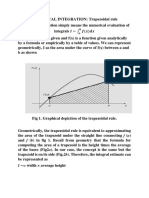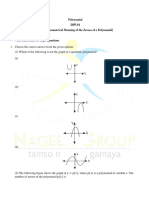STutorial 08
Uploaded by
sohith405STutorial 08
Uploaded by
sohith405Section
Tutorial Sheet 8
Numerical Calculus
~
1. Find the value of the constant C for which Simpson’s rule gives the exact value
of the integral
!1 " #
4 1 2
x + Cx + dx.
2
0
~
2. A function f has the values shown below:
x 1 1.25 1.5 1.75 2
.
f (x) 9 7 6 5 3
~ $2
i) Use Simpson’s rule to approximate 1 f (x) dx.
-
ii) Use composite trapezoidal and composite Simpson’s rules to approximate
$2
1
f (x) dx.
~
3. Obtain the degree of precision of Simpson’s rule.
$b
~
4. Obtain an expression for the arithmetic error in approximating the integral a
f (x) dx
$
0.75
using Simpson’s rule. Consider e−x dx. Give an estimate for the arithmetic
−0.25
error involved in the Simpson’s rule if the approximate function values have at
least 6 significant digits when compared to the true values.
~
5. Use the Gaussian quadrature formula with n = 1 to obtain an approximate value
of
!3
2
e−x dx.
1
~
6. For f ∈ C 2 [a, b], derive the backward difference formula for f " (x) using the method
of undetermined coefficients. Obtain the mathematical error and the arithmetic
error for this formula. Also find the upper bound for the total error.
Determine the optimal value of h > 0 (the distance between the nodes involved
in the formula) for which the upper bound for the total error obtained above is
minimum.
O
7. Let f ∈ C [a, b]. Find the mathematical error and the order of the approximation
3
f (x) − 2f (x − h) + f (x − 2h)
f "" (x) ≈ .
h2
1
S. Sivaji Ganesh and S. Baskar Spring 2022-23
You might also like
- Chapter 4 Numerical Differentiation and Integration 4.3 Elements of Numerical IntegrationNo ratings yetChapter 4 Numerical Differentiation and Integration 4.3 Elements of Numerical Integration9 pages
- Part 5: Integration and DifferentiationNo ratings yetPart 5: Integration and Differentiation40 pages
- b−a n π h f x x x …+2 f x f x π f (0) +2 f π f (π) π f (0) +2 f π π f (π) πNo ratings yetb−a n π h f x x x …+2 f x f x π f (0) +2 f π f (π) π f (0) +2 f π π f (π) π5 pages
- Numerical Integration and DifferentiationNo ratings yetNumerical Integration and Differentiation2 pages
- Composite Numerical Integration: Restart With (Plots)No ratings yetComposite Numerical Integration: Restart With (Plots)9 pages
- Chapter 12-b: Integral Calculus - ExtraNo ratings yetChapter 12-b: Integral Calculus - Extra24 pages
- Calculus for the Life Sciences 2nd Edition Greenwell Solutions Manual - Download Today With Full ContentNo ratings yetCalculus for the Life Sciences 2nd Edition Greenwell Solutions Manual - Download Today With Full Content62 pages
- ES-341: Numerical Analysis: Dr. Mazhar Ali Mehboob Ul Haq (TA)No ratings yetES-341: Numerical Analysis: Dr. Mazhar Ali Mehboob Ul Haq (TA)21 pages
- Calculus 141, Section 8.6 The Trapezoidal Rule & Simpson's RuleNo ratings yetCalculus 141, Section 8.6 The Trapezoidal Rule & Simpson's Rule4 pages
- UECM1693/UECM2623/UGCM2623 Tutorial N1: Numerical Differentiation & IntegrationNo ratings yetUECM1693/UECM2623/UGCM2623 Tutorial N1: Numerical Differentiation & Integration2 pages
- Very-High-Precision Normalized Eigenfunctions For A Class of SCHR Odinger Type EquationsNo ratings yetVery-High-Precision Normalized Eigenfunctions For A Class of SCHR Odinger Type Equations6 pages
- Chapter 4: Integrals: by Assoc - Prof. Mai Duc ThanhNo ratings yetChapter 4: Integrals: by Assoc - Prof. Mai Duc Thanh23 pages
- Numerical Differentiation and Integration:, X,, We Attempt To Estimate A Derivative F (C) or An IntegralNo ratings yetNumerical Differentiation and Integration:, X,, We Attempt To Estimate A Derivative F (C) or An Integral10 pages
- Calculus for the Life Sciences 2nd Edition Greenwell Solutions Manual PDF Download Full Book with All Chapters100% (9)Calculus for the Life Sciences 2nd Edition Greenwell Solutions Manual PDF Download Full Book with All Chapters42 pages
- Download Study Resources for Calculus for the Life Sciences 2nd Edition Greenwell Solutions Manual100% (6)Download Study Resources for Calculus for the Life Sciences 2nd Edition Greenwell Solutions Manual70 pages
- Calculus for the Life Sciences 2nd Edition Greenwell Solutions Manualpdf download100% (5)Calculus for the Life Sciences 2nd Edition Greenwell Solutions Manualpdf download57 pages
- Calculus for the Life Sciences 2nd Edition Greenwell Solutions Manual - Read Online Or Download Now100% (4)Calculus for the Life Sciences 2nd Edition Greenwell Solutions Manual - Read Online Or Download Now60 pages
- NUMERICAL INTEGRATION_Presented by_VANDANA VERMANo ratings yetNUMERICAL INTEGRATION_Presented by_VANDANA VERMA25 pages
- Calculus for the Life Sciences 2nd Edition Greenwell Solutions Manual pdf download100% (3)Calculus for the Life Sciences 2nd Edition Greenwell Solutions Manual pdf download45 pages
- Factoring and Algebra - A Selection of Classic Mathematical Articles Containing Examples and Exercises on the Subject of Algebra (Mathematics Series)From EverandFactoring and Algebra - A Selection of Classic Mathematical Articles Containing Examples and Exercises on the Subject of Algebra (Mathematics Series)No ratings yet
- Engineering Optimization: Concepts and ApplicationsNo ratings yetEngineering Optimization: Concepts and Applications34 pages
- Thesis Fuzzy Linear Programming Problems Solved With Fuzzy Decisive Set Methods Shembujt Te Zgjidhur PDFNo ratings yetThesis Fuzzy Linear Programming Problems Solved With Fuzzy Decisive Set Methods Shembujt Te Zgjidhur PDF32 pages
- Numerical Analysis Math446/OR481 - DL1 Mid-Terms Exam Fall 2022No ratings yetNumerical Analysis Math446/OR481 - DL1 Mid-Terms Exam Fall 20223 pages
- Practice Problems Related To Root Finding Methods With AnswersNo ratings yetPractice Problems Related To Root Finding Methods With Answers3 pages
- Lecture Notes On Mathematical Olympiad Courses For Junior Section Vol. 1No ratings yetLecture Notes On Mathematical Olympiad Courses For Junior Section Vol. 112 pages
- Computer Programming and Application: 3 Interpolation and Curve FittingNo ratings yetComputer Programming and Application: 3 Interpolation and Curve Fitting43 pages
- Numerical Integration Method Comparation (Fixed)No ratings yetNumerical Integration Method Comparation (Fixed)11 pages





























































































